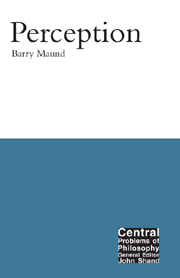Book contents
- Frontmatter
- Contents
- Preface
- 1 The philosophy of perception
- 2 A theory of natural realism
- 3 Theories of perceptual experiences
- 4 Representationalism: representations as natural signs
- 5 Natural realism: Putnam, Austin and Heidegger
- 6 Perception: the argument from illusion
- 7 The phenomenal and phenomenological senses of “looks”
- 8 Types of perceptual content
- 9 The representationalist–intentionalist thesis
- 10 Adverbialist accounts of perceptual experience
- Conclusion
- Notes
- References
- Index
7 - The phenomenal and phenomenological senses of “looks”
- Frontmatter
- Contents
- Preface
- 1 The philosophy of perception
- 2 A theory of natural realism
- 3 Theories of perceptual experiences
- 4 Representationalism: representations as natural signs
- 5 Natural realism: Putnam, Austin and Heidegger
- 6 Perception: the argument from illusion
- 7 The phenomenal and phenomenological senses of “looks”
- 8 Types of perceptual content
- 9 The representationalist–intentionalist thesis
- 10 Adverbialist accounts of perceptual experience
- Conclusion
- Notes
- References
- Index
Summary
There is a common thread to the Austin–Putnam discussion of natural realism, and the more general discussion of the argument from illusion: that understanding what it is for something to appear to perceivers, of what it is to taste, feel, look, sound, smell and so on, a certain way, is of vital importance. Not only is such an account important in understanding the epistemological role of perception, but it is crucial for the assessment of the forms of realism – direct, indirect and natural – and especially of adverbialist theories of realism. Indeed, it is crucial to providing a satisfying philosophical account of perception.
In discussions of perception it is common to find a distinction drawn between the phenomenal (phenomenological) sense of “looks” (and of tastes, etc.) and other senses, for example, an epistemic (or doxastic) sense and a comparative sense. It is the phenomenal sense that is crucial in the setting out and defence of most theories of perception. Not only is this sense relied upon in the argument from illusion, but it has a central role to play for those who reject the argument from illusion, for example, Dretske and Tye.
In this chapter I shall attempt to set out a framework for thinking about the different uses of “looks”. Within that framework, I shall attempt to provide an account of the phenomenological sense of “looks”. In concentrating on “looks”, I shall take it as a model for other “appears” terms: sounds, feels, tastes, smells and so on.
- Type
- Chapter
- Information
- Perception , pp. 131 - 148Publisher: Acumen PublishingPrint publication year: 2002

